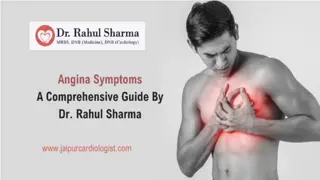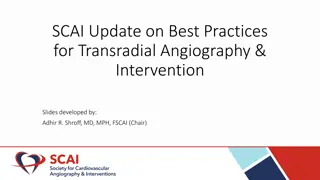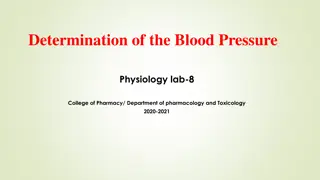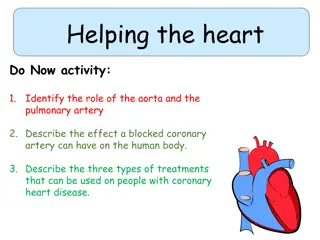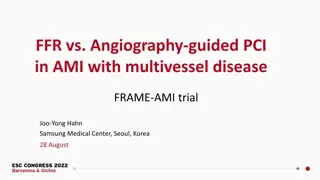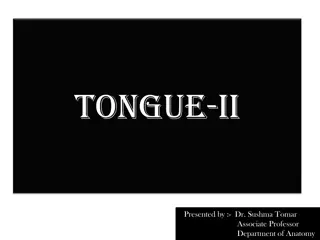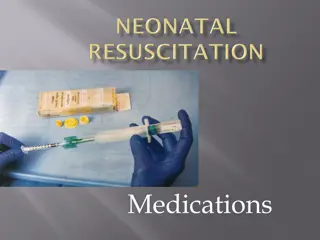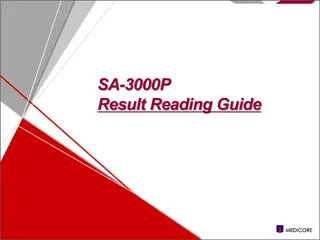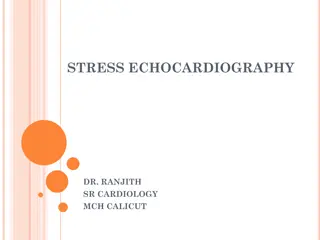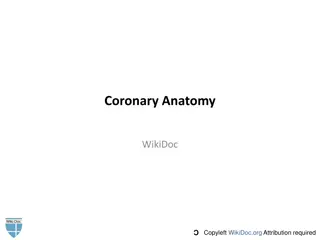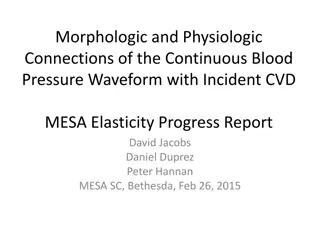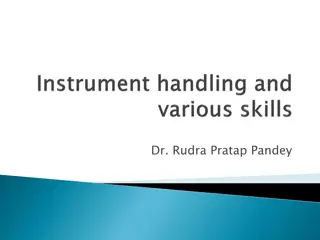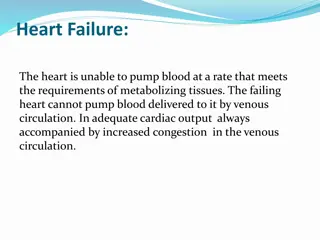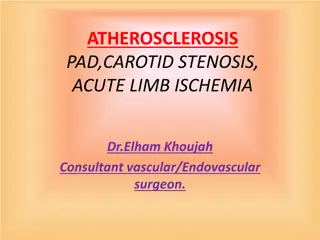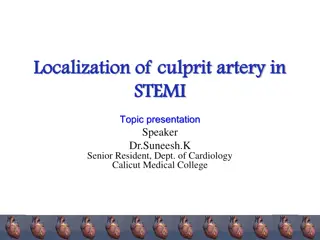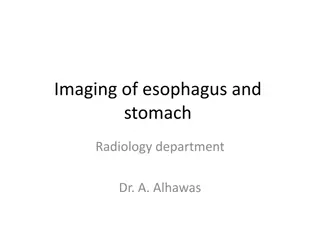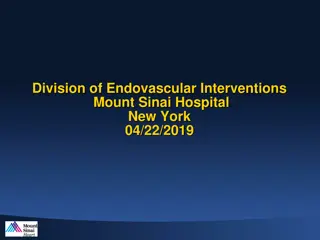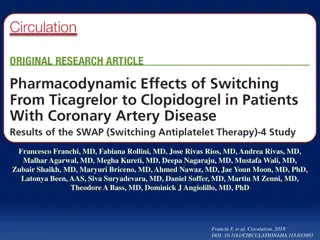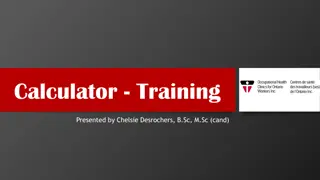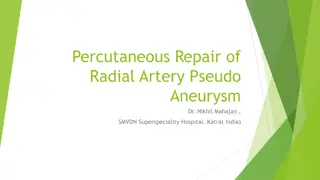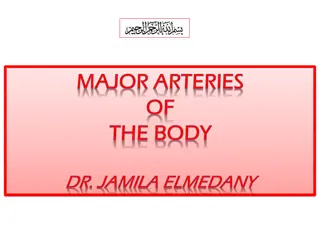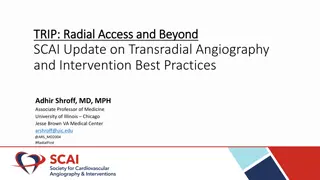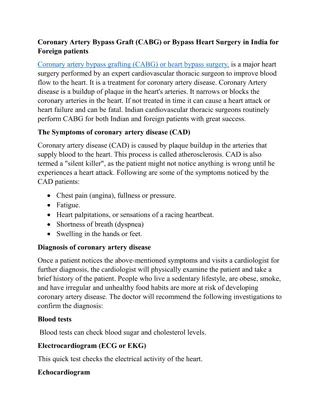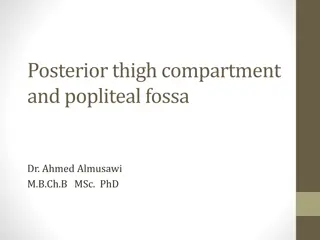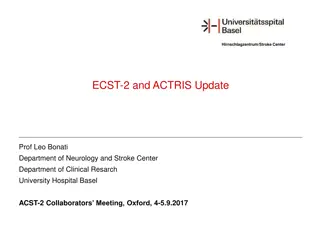The Popliteal Fossa
The popliteal fossa, a shallow depression at the back of the knee joint that serves as a passage for main vessels and nerves. Discover its boundaries, roof, floor, and contents like the popliteal artery, popliteal vein, tibial nerve, and common fibular nerve.
3 views • 9 slides
Insights on Heart Health and Prevention by Dr. Donald Clark III (Trey), MD MPH
Discover key information on cardiovascular disease, ways to enhance heart health, and the importance of prevention from cardiologist Dr. Donald Clark III (Trey), MD MPH. Gain insights on the impact of conditions like coronary artery disease and stroke, as well as practical tips to manage blood press
0 views • 18 slides
Liver Transplant in India for treatment
Liver is the largest gland in our body, and an important metabolic organ which carries out many essential biological functions. The liver is a wedge-shaped, reddish-brown in color with two lobes of different size and shape. The approximate weight of a human liver is 1.5 kilograms. It is in the upper
5 views • 2 slides
Point-of-Care Ultrasound in Neonatal ETT Positioning
Point-of-care ultrasound (POCUS) is emerging as a potential tool for confirming endotracheal tube (ETT) positioning in neonates, providing a viable alternative to X-ray examination. The study aims to assess the accuracy of POCUS in determining ETT placement, particularly by using the superior aspect
2 views • 25 slides
Understanding Coronary Artery Bypass Graft (CABG) in Adult Nursing
Coronary Artery Bypass Graft (CABG) is a surgical procedure where a blood vessel from another part of the body is grafted onto an occluded coronary artery to bypass blockages. This procedure is less common in women compared to men and is typically indicated for severe coronary artery disease. It is
5 views • 15 slides
Understanding the Anterior Compartment of Leg and Foot Anatomy
Explore the anatomy of the anterior compartment of the leg and foot, focusing on structures like the anterior tibial artery, deep peroneal nerve, and dorsalis pedis artery. Learn about their origin, course, relations, and branches, as well as conditions like foot drop and fresher's syndrome. The pre
6 views • 17 slides
Understanding Cardiac Rehabilitation and Physiotherapy Approaches
Explore the comprehensive agenda covering topics like the general structure of the circulatory system, blood circulation in the human body, risk factors for cardiovascular diseases, and physiotherapeutic approaches in cardiac rehabilitation. Gain insights into the anatomy of the heart, arteries, vei
6 views • 14 slides
Cardiologist In Jaipur-Dr Rahul Sharma
Angina Symptoms: Angina is a condition characterized by chest pain or discomfort caused by reduced blood flow to the heart muscle. It\u2019s often a symptom of underlying coronary artery disease, which occurs when the arteries that supply blood to the heart become narrowed or blocked by plaque build
1 views • 6 slides
Understanding Panic Disorder: Symptoms, Diagnosis, and Management
Panic disorder is characterized by sudden, intense surges of fear or discomfort known as panic attacks. Individuals with this disorder may experience symptoms like chest pain, shortness of breath, dizziness, and a fear of having a heart attack. Differential diagnosis includes conditions like coronar
0 views • 8 slides
Understanding the Blood Supply of the Brain
The brain receives its blood supply from four major arteries - two vertebral arteries and two internal carotid arteries. The vertebral arteries branch into the basilar artery, which gives rise to various important branches. The internal carotid arteries supply the anterior and middle cerebral arteri
1 views • 30 slides
Best Practices for Transradial Angiography & Intervention Update
Expert consensus statements provide guidance on utilizing ultrasound guidance for arterial access, preferring radial over ulnar artery access, and the utility of non-invasive collateral flow assessment. Recommendations include administering heparin post-sheath placement and using low-profile sheaths
0 views • 7 slides
Understanding Blood Pressure Physiology in a Lab Setting
Blood pressure (BP) is the lateral pressure exerted by the column of blood on the artery wall. This lab aims to determine BP at rest and after exercise using a sphygmomanometer and stethoscope. Learn about systolic and diastolic pressures, pulse pressure, and mean arterial pressure. Methods include
1 views • 17 slides
Understanding Heart Health: A Comprehensive Guide
Explore the critical roles of the aorta, pulmonary artery, and coronary arteries in heart function. Discover the impact of a blocked coronary artery and learn about treatments for coronary heart disease. Delve into common heart problems, like leaky valves and irregular heartbeat, and how innovations
0 views • 15 slides
Comparison of FFR-guided PCI vs Angiography-guided PCI in AMI with Multivessel Disease: FRAME-AMI Trial
In patients with acute myocardial infarction (AMI) and multivessel coronary artery disease, this study aims to compare fractional flow reserve (FFR)-guided PCI with angiography-guided PCI for non-infarct-related artery lesions. The hypothesis is that selective PCI guided by FFR is superior to routin
2 views • 23 slides
Understanding the Intrinsic Muscles of the Tongue - Anatomy and Physiology Overview
In this detailed presentation by Dr. Sushma Tomar, Associate Professor of Anatomy, the intrinsic muscles of the tongue are explored, along with their functions, arterial and venous supply, lymphatic drainage, and nerve supply. The lecture covers the four intrinsic muscles in each half of the tongue,
1 views • 15 slides
Neonatal Medication Administration and Resuscitation Overview
Neonatal resuscitation may involve administering medications like epinephrine and volume expanders in specific situations such as hypovolemic shock. Before giving medications, ensure proper ventilation and compressions. Epinephrine helps with coronary artery perfusion and oxygen delivery, while volu
1 views • 15 slides
Comprehensive Health Assessment and Wellness Analysis Guide
This guide provides detailed insights into assessing autonomic balance, stress levels, and cardiovascular health through various parameters like SDNN, HRV, ANS activity, and artery state. Understanding these factors can help in determining overall health status and potential risks associated with au
0 views • 4 slides
Understanding the Significance of Lipids in Physiology
Explore the world of lipids, their classifications, physiological importance, and implications in clinical conditions. Understand the functions of simple and complex lipids, their role in energy storage, cell signaling, and disease associations. Dive into the diverse functions and classifications of
0 views • 28 slides
Comprehensive Guide to Stress Echocardiography in Cardiology Practice
Stress echocardiography is a valuable tool in diagnosing and managing coronary artery disease, valvular heart disease, and assessing heart function. This imaging technique helps in detecting flow-limiting stenosis, understanding the ischemic cascade, and evaluating cardiac function during stress. Va
0 views • 49 slides
ACST-2 Trial: Stenting vs. Surgery for Carotid Artery Stenosis
ACST-2 is a randomized trial comparing carotid artery stenting (CAS) versus carotid artery surgery (CEA) in asymptomatic patients with severe carotid stenosis. The trial, published in The Lancet in August 2021, involved 3625 patients. While surgery has been shown to reduce stroke rates, modern medic
0 views • 19 slides
Understanding Coronary Artery Anatomy and Dominance
Explore the intricate details of coronary artery anatomy with a focus on the right and left coronary arteries, as well as variations such as large right dominance, small right dominance, co-dominance, and left dominance. Learn about the importance of understanding these structures in relation to car
0 views • 8 slides
Morphologic and Physiologic Connections in Blood Pressure Waveforms for Cardiovascular Event Prediction
This report discusses the morphologic and physiologic connections in continuous blood pressure waveforms and their association with incident cardiovascular events. The study aims to assess if changes in arterial elasticity contribute to predicting CVD events and explores additional measures derived
0 views • 30 slides
Surgical Instrument Techniques and Grips Overview
Explore a detailed guide on various surgical instruments, grips, and techniques including needle manipulation, tissue forceps usage, and artery forceps variations. Enhance your surgical skills and knowledge with practical insights.
0 views • 13 slides
Understanding High Blood Pressure: Causes, Risks, and Management
High blood pressure, or hypertension, is a condition where the blood exerts elevated force against artery walls, leading to increased heart workload and potential damage to arteries. It poses risks for heart disease, stroke, and kidney issues. Pre-hypertension and danger zones indicate different sta
1 views • 15 slides
Understanding Hypertension: Causes, Symptoms, and Management
Blood pressure is the force of blood against the artery walls. Hypertension, or high blood pressure, can lead to serious health risks like heart disease, stroke, and kidney failure. Primary hypertension may be caused by factors like heredity, obesity, and stress, while secondary hypertension can be
2 views • 20 slides
Understanding Heart Failure and Congenital Heart Diseases
Heart failure is a condition where the heart struggles to pump blood efficiently, leading to various complications. It can affect different sides of the heart, with causes ranging from coronary artery disease to valve problems. Congenital heart diseases, on the other hand, are common anomalies prese
0 views • 19 slides
Understanding Atherosclerosis, Peripheral Artery Disease, and Carotid Stenosis
This informative content details the histo-anatomy of blood vessels, pathophysiology of atherosclerosis, peripheral ischemia, and carotid artery disease. It covers the definition, risk factors, and processes involved in atherosclerosis, including endothelial cell function, blood flow dynamics, and f
3 views • 24 slides
Screening for Peripheral Vascular Disease in Patients with Coronary Artery Disease
Patients with coronary artery disease should be screened for peripheral vascular disease as it is a frequent integrator of global cardiovascular risk. The association of atherosclerosis in various arterial diseases highlights the importance of identifying multisite artery disease. The prevalence and
0 views • 23 slides
Understanding Culprit Artery Localization in STEMI: Insights from a Cardiology Presentation
Dr. Suneesh K., a Senior Resident in the Dept. of Cardiology at Calicut Medical College, delves into the crucial role of ECG analysis in identifying the culprit artery during ST-elevation myocardial infarction (STEMI). This presentation covers coronary circulation, blood supply of the heart, prevale
0 views • 83 slides
Anatomy and Blood Supply of the Equine Stomach
The equine stomach is relatively small compared to the horse's body size, with distinct regions such as the cardia, fundus, body, and pyloric region. It is located on the left side of the abdomen, under the ribs. The stomach's blood supply includes branches from the aorta, splenic artery, and hepati
0 views • 23 slides
Radiology Imaging of Esophagus and Stomach by Dr. A. Alhawas
View detailed radiology imaging of the esophagus and stomach conducted by Dr. A. Alhawas, showcasing various anatomical structures such as the splenic artery, abdominal aorta, common hepatic artery, and more. Explore pathologically changed layers in pyloric stenosis, arterial blood supply to the pyl
0 views • 8 slides
Endovascular Interventions at Mount Sinai Hospital: Case Study
Division of Endovascular Interventions at Mount Sinai Hospital, New York, treated a 71-year-old female patient with bilateral lower extremity claudication using endovascular procedures. The patient had a history of hypertension, diabetes, hyperlipidemia, and smoking, with peripheral artery disease a
0 views • 27 slides
Pharmacodynamic Effects of Switching from Ticagrelor to Clopidogrel in Patients with Coronary Artery Disease: SWAP-4 Study
Pharmacodynamic effects of switching P2Y12 inhibitors from ticagrelor to clopidogrel in coronary artery disease patients were investigated in the SWAP-4 study. De-escalation between these agents is common for various reasons. The study assessed the impact of clopidogrel loading dose, maintenance dos
0 views • 11 slides
Ergonomic Measurement Guide for Proper Posture Setup
Learn how to measure seat height, armrest height, seat pan depth, desk height, screen height, keyboard and mouse height, buttock-popliteal length, popliteal height, knee height, elbow height, and eye height for optimal ergonomic setup. Helpful visuals and tips provided.
0 views • 25 slides
Percutaneous Repair of Radial Artery Pseudoaneurysm - Case Study
A 61-year-old male with a history of diabetes, hypertension, and coronary artery disease presented with abnormal body movements suggestive of seizures. Following admission and neurology evaluation, a radial artery pseudoaneurysm was incidentally discovered. Percutaneous transluminal angioplasty (PTA
0 views • 5 slides
Understanding Arteries: Anatomy and Function Overview
Explore the key concepts related to arteries, including their definition, anastomosis, end arteries, aorta divisions, and major artery distribution in the body. Learn about the general principles of arteries and their role in blood circulation, emphasizing the importance of anastomoses. Dive into th
0 views • 21 slides
Best Practices for Transradial Angiography and Intervention
This update highlights best practices for transradial angiography and intervention, including topics such as ultrasound guidance for transradial access, ulnar artery access recommendations, and future study opportunities. The importance of developing proficiency with ultrasound guidance, utilizing r
0 views • 15 slides
Coronary Artery bypass graft - Bypass heart surgery
Coronary artery bypass grafting (CABG) or heart bypass surgery, is a major heart surgery performed by an expert cardiovascular thoracic surgeon to improve blood flow to the heart. It is a treatment for coronary artery disease. Coronary Artery disease
0 views • 3 slides
Posterior Thigh Compartment and Popliteal Fossa Overview
Explore the boundaries, contents, muscles, blood supply, nerve supply, and structures of the posterior thigh compartment and popliteal fossa. Study the cutaneous innervation, sciatic nerve, popliteal artery, and detailed anatomy of this region through informative images and descriptions provided by
0 views • 16 slides
Exploring the Latest Research on Carotid Artery Disease Treatment
This comprehensive update discusses recent findings and ongoing studies related to carotid artery disease treatment options, particularly focusing on revascularization procedures in symptomatic and asymptomatic patients. Key trials like ECST-2, ACTRIS, EVA-3S, SPACE, ICSS, CREST, and more are highli
0 views • 25 slides







